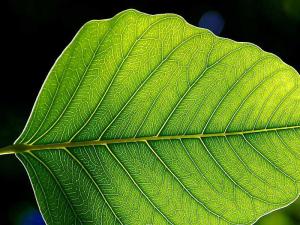3) Life on Earth depends on, is shaped by, and affects climate.
 A leaf with sunlight shining through it.
A leaf with sunlight shining through it.The third principle discusses where biology and climate meet.
The first part refers to the obvious dependences that living things have on the climate system: we humans, for example, can only survive within a particular range of temperatures, concentration of oxygen in the atmosphere, and so on.
The second part of the statement refers to how living things have evolved within the context of the climate system, either adapting to changes in the environment or going extinct.
The last part of the statement — that life affects climate — has been true for billions of years, beginning when early organisms altered the global chemistry of the atmosphere and continuing today, with plants in effect inhaling carbon dioxide through photosynthesis in the spring and summer, and then releasing carbon back into the atmosphere through decay in the fall and winter.
Climate’s links through the carbon cycle to biology and life sciences are often overlooked, misunderstood, or underappreciated.
CLEAN’s “Teaching Essential Principle 3” provides overview of the content, why it is important, related pedagogical challenges, and examples of high quality resources by grade level.
Continue to the next section to find out how climate varies over space and time through both natural and artificial processes .
